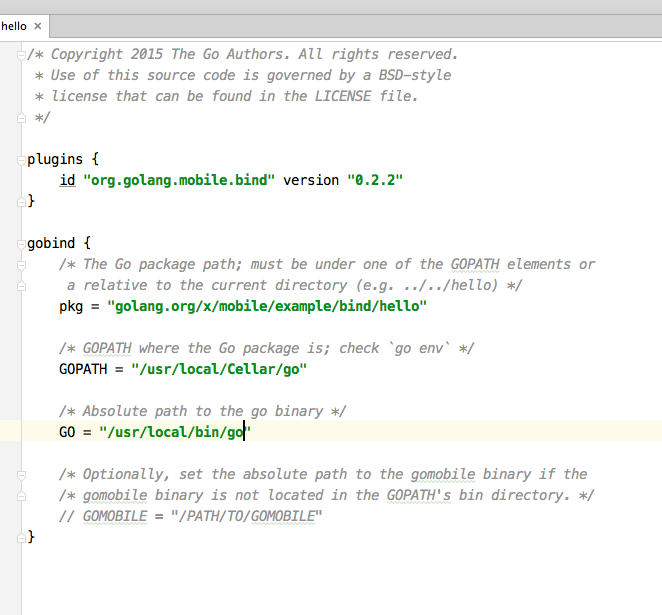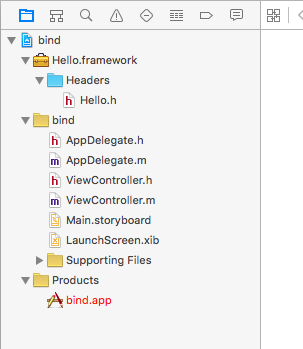iOS and Android Programming with Go
2015-12-12 16:00
489 查看
Whilst not a new language, Go has gained a lot of interest over the past two years and the number of bigger name projects utilizing the language is growing rapidly. I wrote an introductory article on the language for SitePoint and came across mentions of mobile support, so thought I’d take a look at the possibilities. I was most excited to see what Go support on Android was like as they are both Google technologies and there have been rumblings of support from developers for a language to replace Java. Getting Started You will need GoLang 1.5+ installed. Next install the GoMobile tool which compiles and runs pre-existing Go applications for Android and iOS:
go get golang.org/x/mobile/cmd/gomobile gomobile init
We will be referring to the example applications shipped with the gomobile package in GoLangInstalldir/src/golang.org/x/mobile/example/. If you don’t have them installed, fetch them with this command:
go get -d golang.org/x/mobile/example/basic
Build and Install a Native Go Application
For many application use cases, compiling Go to a native application and ignoring platform libraries and interfaces may be fine. If so it’s simple to compile your existing Go code, with a subset of functionality available. This includes:
App control and configuration
OpenGL ES 2 bindings
Asset management
Event management
Experimental packages include OpenAL bindings,audio, font, sprite and motion sensors
We will be using one of the pre-existing gomobile examples to step through the process, but these can be replaced with your own project files.
Android
Build an Android APK
gomobile build -target=android golang.org/x/mobile/example/basic
Deploy to a Device
gomobile install golang.org/x/mobile/example/basic
iOS
Build an iOS IPA
gomobile build -target=ios golang.org/x/mobile/example/basic
Deploy to a device
There is no equivalent command for deployment on iOS as on Android, so after creating the app above you will have to follow your own personal favorite way of copying it to a device or emulator, such as the ios-deploy tool. For something a bit more exciting, also try the steps above with the golang.org/x/mobile/example/audio example. Let’s take a look inside the audio example (I wont reproduce the complete code here) and you don’t need to be overly familiar with GoLang (I’m not), this is more about looking at what is possible. Firstly you see a set of import statements:
import ( ... "golang.org/x/mobile/app" "golang.org/x/mobile/asset" ... )
If you dig around the folders and files that are imported in GoLangInstalldir/src/golang.org/x/mobile/* you will notice the various Java and Objective-C files that are compiled with your code. Digging further you will see references to some of the classes imported and used in the code, such as app and glctx.
Going Native
We can code in Go and build a compact and optimized native app, but it’s not very ‘native-like’ right now, as all the required support libraries are only available in Java and Objective-C / Swift. How can we improve this experience? The Go Mobile team have created another option, using go packages (your applications) inside a native application. Perfect for sharing some common Go code and binding to native code. It’s easy to get started, but may be complex to maintain in the long run.
Android
If you’re using Android Studio, import the reference project from GoLangInstalldir/src/golang.org/x/mobile/example/bind/android and open the build.grade (Module: hello) file to update your GOPATH and GO paths, here are mine (I installed GoLang with Homebrew):

Sync Gradle and the application is then deployable to an emulator or device.
Note: Currently this is only supported on ARM based devices and emulators.
Let’s look at the Java and Go code:
MainActivity.java
package org.golang.example.bind;
import android.app.Activity;
import android.os.Bundle;
import android.widget.TextView;
import go.hello.Hello;
public class MainActivity extends Activity {
private TextView mTextView;
@Override
protected void onCreate(Bundle savedInstanceState) {
super.onCreate(savedInstanceState);
setContentView(R.layout.activity_main);
mTextView = (TextView) findViewById(R.id.mytextview);
// Call Go function.
String greetings = Hello.Greetings("Android and Gopher");
mTextView.setText(greetings);
}
}src/golang.org/x/mobile/example/bind/hello/hello.go
package hello
import "fmt"
func Greetings(name string) string {
return fmt.Sprintf("Hello, %s!", name)
}The go file is imported with import go.hello.Hello and the Greetings function within it accessible in the Java file via Hello.Greetings. With not too many extra steps, bindings between go functions and native UI elements are possible.
iOS
Binding an iOS application to Go requires different steps. First execute the following commands:
cd GoLang_Install_dir/src/golang.org/x/mobile/example/bind gomobile bind -target=ios golang.org/x/mobile/example/bind/hello
This will create a framework bundle called Hello.framework in the current folder that we can use in our project. Open the sample iOS project found at GoLangInstalldir/src/golang.org/x/mobile/example/bind/ios/bind.xcodeproj in Xcode and drag Hello.framework into the project, checking “Copy items if needed”. This should result in the following folder structure:

Build and run the application which, much like the Android app, calls Go methods into Objective-C code. Let’s look at the code:
#import "ViewController.h"
#import "hello/Hello.h" // Gomobile bind generated header file in hello.framework
@interface ViewController ()
@end
@implementation ViewController
@synthesize textLabel;
- (void)loadView {
[super loadView];
textLabel.text = GoHelloGreetings(@"iOS and Gopher");
}
@end#import "hello/Hello.h" imports the framework file generated earlier and textLabel.text = GoHelloGreetings(@"iOS and Gopher"); calls the function it exposes to set a label variable. It’s possible to use the same auto-generated Objective-C framework file in a Swift based project and then use something like:
let msg = Hello.GoHelloGreetings("gopher")Is It worth It?
Well, in short, probably not. If you’re already programming your applications in Go and you’re OK with non-native looking interfaces then there’s nothing stopping you, as you can see it’s easy to build and deploy native applications written in Go. If you’re willing to take the extra steps to follow the binding option then you can take things a lot further, but still within certain limitations. If you’re not using Go, then it’s likely not worth considering as a mobile native programming option yet. But I still feel strongly that there is enough potential and interest to make it a possibility in the not-distant-future and would of course, love to hear your opinions below.
转自:http://www.sitepoint.com/ios-and-android-programming-with-go/
相关文章推荐
- 使用C++实现JNI接口需要注意的事项
- Android IPC进程间通讯机制
- Android Manifest 用法
- [转载]Activity中ConfigChanges属性的用法
- Android之获取手机上的图片和视频缩略图thumbnails
- Android之使用Http协议实现文件上传功能
- Android学习笔记(二九):嵌入浏览器
- android string.xml文件中的整型和string型代替
- i-jetty环境搭配与编译
- android之定时器AlarmManager
- android wifi 无线调试
- Android Native 绘图方法
- Android java 与 javascript互访(相互调用)的方法例子
- android 代码实现控件之间的间距
- android FragmentPagerAdapter的“标准”配置
- Android"解决"onTouch和onClick的冲突问题
- android:installLocation简析
- android searchView的关闭事件
